I recently read an article about an elephant hunter in Gabon (Africa) who was ambushed by his quarry and trampled to death. This led me to reflect upon my own transitory but fascinating encounters with elephants.
You first may be prompted to ask, how could a person be ambushed by an elephant? This is certainly a reasonable question given the size of the animal we are discussing. An African forest elephant (the executioner in this case) typically nudges the scales at nearly three tons. That is a weight equal to around 20 NFL linemen. An African savannah (or bush) elephant weighs twice as much with big males reaching nearly six and a half tons. Given this weight, and with the padded base of each appendage having a circumference of four feet, one might doubt that any degree of stealthiness would be possible for such an enormous quadruped. Alas, the would-be Gabonese hunter found out much too late that elephants are quite capable of such feats of craftiness.
I recall another interesting tale whereby I first learned of the potential for incredible quietness and cunningness elephants possess.

The photo above shows a group of elephants in the American Museum of Natural History in New York City. The display was begun in 1915 by Carl Akeley who also collected some of the specimens. I first heard of Akeley when I ran across his autobiography in my high school library. Published in 1923, In Brightest Africa is something of a swashbuckling tale of an Indiana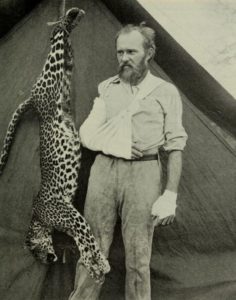 Jones-type adventurer/explorer/big game hunter. Such a story should be expected from a man who killed an attacking leopard with his bare hands. His book is still a fascinating narrative although the recounting of his hunts of charismatic animals, such as elephants and gorillas, will trouble many readers.
Jones-type adventurer/explorer/big game hunter. Such a story should be expected from a man who killed an attacking leopard with his bare hands. His book is still a fascinating narrative although the recounting of his hunts of charismatic animals, such as elephants and gorillas, will trouble many readers.
Perhaps even more noteworthy, was Akeley’s skill as a taxidermist. He was a pioneer in this field and many consider him the “father” of this specialty. He really did elevate taxidermy to an art form. I saw my first Akeley taxidermies at the Field Museum of Natural History in Chicago. I recall being stunned upon seeing how lifelike his work was. The delineation of muscle masses, tendons, and even blood vessels beneath the skin made the animals look as though they might walk right out of their dioramas at any moment.
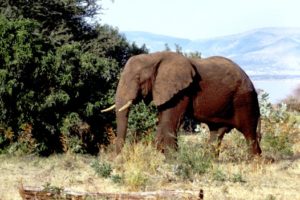 But back to the story; it was during one hunt in Africa that Akeley himself learned just how quietly and craftily an elephant can approach a pursuer. Hunting for museum specimens, he was stalking a group of three bulls. Akeley at last heard the crashing sounds of feeding coming from a bamboo forest 200 yards ahead. Pausing to appraise the rifle and cartridges his gun-bearer had handed him, Akeley: was suddenly conscious that an elephant was almost on top of me. I have no knowledge of how the warning came. I have no mental record of hearing him, seeing him, or of any warning from the gun boy. . . My next mental record is of a tusk right at my chest. Akeley instinctively grabbed the tusk and swung in between the two. This he had practiced in his mind in anticipation of such an attack and he believed this “rehearsing” is what saved his life.
But back to the story; it was during one hunt in Africa that Akeley himself learned just how quietly and craftily an elephant can approach a pursuer. Hunting for museum specimens, he was stalking a group of three bulls. Akeley at last heard the crashing sounds of feeding coming from a bamboo forest 200 yards ahead. Pausing to appraise the rifle and cartridges his gun-bearer had handed him, Akeley: was suddenly conscious that an elephant was almost on top of me. I have no knowledge of how the warning came. I have no mental record of hearing him, seeing him, or of any warning from the gun boy. . . My next mental record is of a tusk right at my chest. Akeley instinctively grabbed the tusk and swung in between the two. This he had practiced in his mind in anticipation of such an attack and he believed this “rehearsing” is what saved his life.
The bull knocked him down and proceeded to place its curled-up trunk on Akeley in an attempt to smash him into lifelessness. He drove his tusks into the ground on either side of me, his curled-up trunk against my chest. I had a realization that I was being crushed, and as I looked into one wicked little eye above me I knew I could expect no mercy from it. By some good fortune, the tusks struck rock or root before they plunged deeply enough into the ground for Akeley to be squashed. Still, his injuries were significant. Akeley recalled: I heard a wheezy grunt as he plunged down and then — oblivion. The thing that dazed me was a blow from the elephant’s trunk as he swung it down to curl it back out of harm’s way. It broke my nose and tore my cheek open to the teeth. Had it been an intentional blow it would have killed me instantly. Akeley reported lying there for four or five hours until his porters and gun-bearers worked up the courage to return and check on him. Still he considered himself fortunate that the elephant did not, as he thought usual, return to gore, trample, and/or dismember him.
I suppose, previous to hearing this story, I had not given serious thought as to how dangerous an elephant might be. Growing up on a diet of Johnny Weissmuller Tarzan movies had given me the impression that they were friendly animals and quite amenable to human partnership. A boyhood visit to the Ringling Brothers Barnum & Bailey circus when it came to Terre Haute did nothing to alter my delusion. The elephants obediently marched southward from the train station, down 3rd Street and U.S. 41 to the fairgrounds. They helped erect the big top and later performed beneath it.
It was not until many years later that I got my first hint that elephants were not animals with which to trifle. First there was a lecture I attended during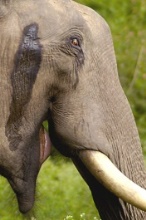 which the presenter spoke about the use of Asian elephants in the logging industry in Thailand. One particular slide stuck in my mind. It showed a male under restraint (one leg chained to a tree) because he was in musth. Musth is the male elephant’s equivalent to the female heat cycle. During musth, the testosterone levels of the male become elevated many fold. The temporal glands on each side of the head produce pheromones which dampen the side of the bull’s head. Additional they tend to produce a constant stream of urine which wets their hind legs and thus marks the path of their wonderings. Woe to a younger, weaker male who crosses this track.
which the presenter spoke about the use of Asian elephants in the logging industry in Thailand. One particular slide stuck in my mind. It showed a male under restraint (one leg chained to a tree) because he was in musth. Musth is the male elephant’s equivalent to the female heat cycle. During musth, the testosterone levels of the male become elevated many fold. The temporal glands on each side of the head produce pheromones which dampen the side of the bull’s head. Additional they tend to produce a constant stream of urine which wets their hind legs and thus marks the path of their wonderings. Woe to a younger, weaker male who crosses this track.
The huge increase in male hormone production during musth makes such males super aggressive. Their hostility can be unpredictably spontaneous and may be directed toward other elephants, humans, or objects in their immediate surroundings. In the case of the male shown in the lecturer’s slide every plant, branch, small log, or other object within reach had been thrown aside in enraged madness. The ground in a circle ranging as far as the restraining chain would allow was swept as clean as a dining room floor. Although sad to see this proud animal so restrained, one needed little imagination to understand what would happen if a person came within reach of such an infuriated, brutally powerful animal.
My next lesson in the wisdom of giving elephants a wide birth came in Malaysia. Trekking through the rainforest from Selangor state over to the neighboring state of Negri Sembilan, my Temuan friends and I came upon an old, streamside encampment. Who had used it, the purpose of their visit – sinister or benevolent – we knew not. Some Asian elephants had also discovered the camp. Had the occupants been driven away we wondered? The camp and its contents had been nearly demolished by the pachyderms. The animals had taken a particular interest in the cookware used by the campers. Their cooking pots had been trod into flattened, tin pancakes. Dodong surmised the elephants had been attracted to the salt residue in the pans.
The impressively huge footprints of the elephants crossed the stream and headed upslope to the northeast. Above the stream their path had forced them to squeeze in between two large trees. They had spent a bit of time wallowing at the brook and their mud-caked bodies had left huge smears of clay on each tree some seven to eight feet above the ground. Our intended path took us up the hill along the same route as the elephants. Within an hour or so we had gained on the small herd and could hear them in the distance. There was the typical crashing sound of vegetation being pulled into reach and broken. Low rumbles, snorts, and squeaks indicated a group feeding in a leisurely, stress-free way. Eager to actually see a group of Asian elephants in their natural habitat, I urged my companion Dodong to guide us close enough for a good look. His reply was based upon a lifetime of wisdom gained by daily exposure to the forest and its creatures and it put a decisive halt to my hope. The answer was short and sweet and accompanied by a look I took to mean, “Are you crazy?” Mereka jahat (“they are mean”), he said! With that, Dodong proceeded to take us on a quick but cautious detour around what he obviously considered one of the most dangerous animals in his rainforest home.
Years later I was able to at last see wild elephants. These were savannah elephants in the east African country of Tanzania. At our first stop, Arusha N.P., elephants are uncommon and we encountered none. The second park on our route was Lake Manyara N.P. and here we were more fortunate and  saw many elephants. How exciting to finally get to see these fascinating creatures up close as they browsed, tended their young, enjoyed a dust bat, or simply rested in the shade of an immense sausage tree. Here I experienced firsthand the storied silence with which they can move.
saw many elephants. How exciting to finally get to see these fascinating creatures up close as they browsed, tended their young, enjoyed a dust bat, or simply rested in the shade of an immense sausage tree. Here I experienced firsthand the storied silence with which they can move.
As we sat in our Land Rover watching a pair of females browsing the leaves of an acacia, movement in my peripheral vision caught my attention. As I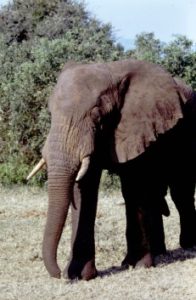 glanced to the right, a young male elephant walked by our vehicle. Although this four-ton animal was within a few yards of the Land Rover, not a hint of the sound of footfall could I detect. It was abruptly very clear to me how one could be focused upon something else, as Akeley had been, and have one of these huge animals stealthily and suddenly materialize upon you. Quite an eye-opening experience it was.
glanced to the right, a young male elephant walked by our vehicle. Although this four-ton animal was within a few yards of the Land Rover, not a hint of the sound of footfall could I detect. It was abruptly very clear to me how one could be focused upon something else, as Akeley had been, and have one of these huge animals stealthily and suddenly materialize upon you. Quite an eye-opening experience it was.
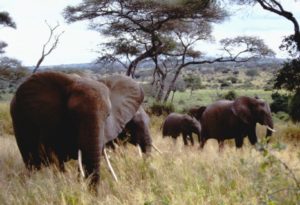 I chose The Silence of Elephants as the title for this composition for another reason too. Not hearing elephants is now more often due to the simple fact that their numbers have been so drastically reduced. This is true in both Asia and Africa. As an example, when we finally reached Tarangire N.P., we had our best success seeing elephants, over 100 in a couple of days’ time. But Akeley, in his aforementioned book, reported seeing 700 elephants in just one, single herd. This was in the early 1900’s
I chose The Silence of Elephants as the title for this composition for another reason too. Not hearing elephants is now more often due to the simple fact that their numbers have been so drastically reduced. This is true in both Asia and Africa. As an example, when we finally reached Tarangire N.P., we had our best success seeing elephants, over 100 in a couple of days’ time. But Akeley, in his aforementioned book, reported seeing 700 elephants in just one, single herd. This was in the early 1900’s
Poaching for their highly prized ivory tusks and loss of habitat to an ever-expanding human population are the two main reasons for the precipitous decline of elephants. The freefall in their populations has been particularly severe since the 1970’s when the price of ivory (mostly destined for the Far East) exploded. The population of elephants in Africa was once thought to be around five million. Today it is estimated that there are about 400 000 remaining. This is a reduction of 92%. Asian elephant populations have declined by 50% and only 40 000 to 50 000 now exist in the wild. China banned the domestic trade in elephant ivory in 2017 but some experts still believe elephants could become extinct in Africa within the next two decades.
Elephants are so amazing in so many ways. How sad to imagine a world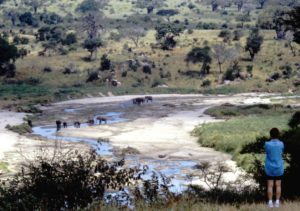 without them. As researchers have come to know more about them, the argument against killing elephants has grown stronger. We now know that there is much going on within that big brain of theirs, the largest of any land mammal.
without them. As researchers have come to know more about them, the argument against killing elephants has grown stronger. We now know that there is much going on within that big brain of theirs, the largest of any land mammal.
It turns out that the old axiom about elephants having long memories is quite true. For example, herds depend on the long-term memories of old females to lead them to remembered water sources in times of drought. Communication among elephants is fascinatingly complex and in 1985 it was discovered that they can converse with one another by using sounds too low in frequency for humans to hear. Such sounds carry for long distances and allow elephants to communicate even when separated by a distance of over two miles. Recently elephant researcher Caitlin O’Connell found that these so-called ultrasounds can travel through the ground surface and elephants actually “hear” them with their feet.
The social behavior of elephants is highly complex. A baby elephant in distress will receive the attention of family members with pats and caresses. The website globalelephants.org notes that elephants “. . . express grief, joy, compassion, self-awareness, and play.”
They display powerful altruism as well. This gallant concern for others of their kind is displayed when they are confronted with injury or death among their herd. Carl Akeley reported long ago that he had observed other elephants gather around a comrade he had wounded and attempt to help the mortally injured bull back on its feet. Elephants have been observed showing reverence for their dead by gently touching the bones of their deceased companion. They may pause at a place where a loved one has died and stand there silently for several minutes. Are they grieving; perhaps remembering past, shared adventures? Given their high degree of intelligence one would certainly have to entertain this as a possibility.
It is believed that elephants are one of only a handful of species that, like humans, can recognize themselves as a unique individual (= self-recognition). As noted, they appear to also have an equally rare (so far as we know) understanding of the concept of mortality. These are incredibly powerful, complicated, higher mental powers. If only we humans could direct some tiny degree of empathy toward these exceedingly extraordinary animals. We would then surely recognize the immorality of killing such kindred beings; especially for trinkets we could well live without. Perhaps greater empathy could then also help us to recognize the terrible depravity of driving any member of the Creation into extinction. This seems particularly obvious when we are dealing with an animal whose mental powers are, in many cases, human-like. With this recognition might come, in the end, the opportunity to avoid the looming silence of elephants.
____________________________________________
Credits: Elephant herd at the AMNH @ commons.wikimedia.org Carl Akeley with leopard specimen @ commons.wikimedia.org Excerpts from In Brightest Africa at – https://archive.org/details/inbrightestafric00akel/page/24/mode/2up?ref=ol&view=theater Elephant in musth by Yathin Krishnappa @ en.wikipedia.com Sausage tree by Bernard DuPont @ commons.wikimedia.org All other photos by the author.
